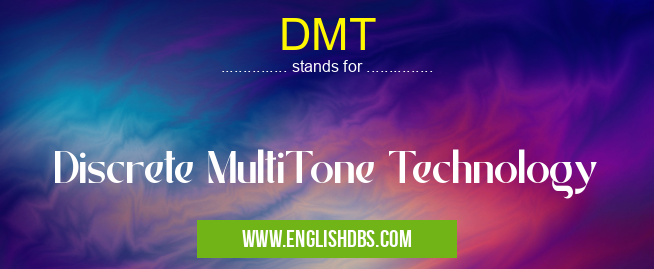What does DMT mean in TECHNOLOGY
DMT (Discrete Multi-Tone Technology) is a digital transmission technique used in various communication systems, including telephone networks and high-speed internet connections. It involves dividing a data stream into multiple subchannels, each carrying a different frequency tone. This approach offers advantages in terms of spectral efficiency and noise immunity.

DMT meaning in Technology in Computing
DMT mostly used in an acronym Technology in Category Computing that means Discrete MultiTone Technology
Shorthand: DMT,
Full Form: Discrete MultiTone Technology
For more information of "Discrete MultiTone Technology", see the section below.
» Computing » Technology
How DMT Works
DMT operates by dividing the available transmission bandwidth into multiple subchannels, each with its own unique frequency tone. The data stream is then modulated onto these subchannels using a technique called quadrature amplitude modulation (QAM). This modulation scheme allows for multiple bits of data to be carried on each subchannel simultaneously.
Advantages of DMT
- Spectral Efficiency: DMT enables efficient utilization of the available bandwidth by dividing it into multiple subchannels. This allows for higher data rates within a limited frequency range.
- Noise Immunity: The subchannels in DMT are designed to be orthogonal to each other, meaning they do not interfere with each other. This provides increased resistance to noise and interference, leading to improved signal quality.
- Scalability: DMT is a scalable technology that can support various data rates and bandwidths. It allows for flexible adaptation to different transmission environments and requirements.
- Robustness: DMT is a robust technology that can handle transmission over various media, including twisted-pair copper cables and optical fiber. Its noise immunity and synchronization mechanisms ensure reliable data transmission even in challenging conditions.
Essential Questions and Answers on Discrete MultiTone Technology in "COMPUTING»TECHNOLOGY"
What is DMT?
Discrete MultiTone (DMT) is a digital modulation technology used in broadband data transmission over copper lines, such as telephone lines or twisted-pair cables. It divides the available bandwidth into multiple narrowband channels, each carrying a different frequency tone.
How does DMT work?
DMT modulates data onto multiple carrier frequencies simultaneously. The sender divides the data into small blocks and assigns each block to a particular frequency tone. The receiver demodulates the data from each tone and reassembles the blocks to reconstruct the original data.
What are the advantages of DMT?
DMT provides several advantages, including:
- Increased data rates over legacy copper lines
- Robustness against noise and interference
- Support for multiple services (e.g., voice, data, video) over a single line
Where is DMT commonly used?
DMT is used in various applications, including:
- Digital Subscriber Line (DSL) technology for high-speed internet access
- Fiber-to-the-Home (FTTH) connections as a last-mile technology
- Cable modems for data transmission over cable TV lines
What is the difference between DMT and OFDM?
Both DMT and Orthogonal Frequency-Division Multiplexing (OFDM) are digital modulation techniques that divide the available bandwidth into subcarriers. However, DMT uses discrete frequency tones, while OFDM uses overlapping subcarriers. OFDM is more spectrally efficient and resistant to certain types of interference.
Final Words: DMT is a versatile and efficient digital transmission technology that plays a crucial role in modern communication systems. Its advantages in spectral efficiency, noise immunity, scalability, and robustness make it a preferred choice for high-speed internet access, voice over IP (VoIP), and other applications that demand reliable and high-quality data transmission.
DMT also stands for: |
|
| All stands for DMT |
